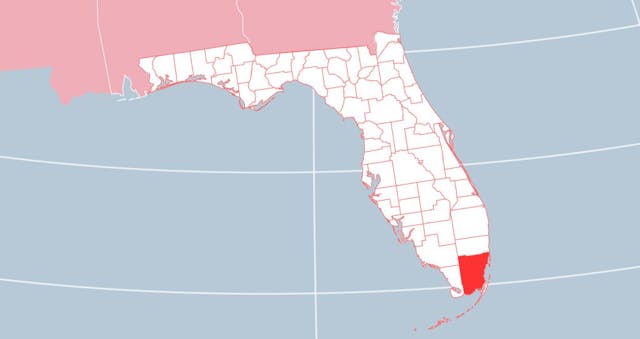Rehabs in Miami Dade
Miami-Dade County is situated in the US State of Florida. The administrative center is in Miami. The latter is also a part of the world’s 34th largest metropolitan area. As of 2020, the city had a population of 6,138 million people. According to the 2020 US Census, Miami-Dade was home to 2,701,767 people. Hence, this number makes it the most populous region in FL and the 7th most populous in the US.
Besides being large, this region is also a party destination for many tourists. Thus, its experience with drug trafficking is much higher than in other regions of FL. It also has serious problems with substance use. The most widely used substance is cocaine. In 2016, 60% of drug-involved deaths were linked to cocaine. Moreover, during the same year, roughly 36 residents were passing away from cocaine per month. According to the County Health Rankings and Roadmaps Report, between 2015 and 2017, there were 828 drug overdose fatalities in this area.
These statistics show how much the people need drug and alcohol rehab in Miami-Dade County, Florida. The facilities are to address the core problems and save as many lives as they can.
In our article, we have tried to gather all the necessary information on these recovery centers. Keep reading to find the support you are in need.
Available Treatment Options
Addiction is a disease that affects all spheres of life. Addicts from every walk of life struggle with this illness. Rehabs in Miami-Dade County, Florida are here to help them in their rocky way towards recovery.
Commonly, rehabs include the following programs:
- Special intervention amenities
- Detox
- Inpatient and outpatient care
- Aftercare
Substance Abuse Evaluation
To reflect an individual’s condition, needs, and medical history, there are evaluation services inside the hubs. Qualified specialists try to conduct a clinical assessment. That is to say, they determine the state of addiction.
The specialist tries to reveal which kind of substances the patient is using and how long they are on them, how many times he/she tried to relapse, the severity of the issue, and the mental condition of the patient.
Detox
Detox involves cleaning the body and getting rid of all heavy substances. It also provides 24-hour medical oversight and tries to make it easier to transition into recovery.
Medications are used to get withdrawal symptoms under control. During detox, the body starts to heal, stabilize and reclaim normal functioning. That is to say, it prepares an individual for further therapies.
Inpatient Program
Inpatient or residential treatment combines various therapies and interactions with a recovery community. Patients live at the facility and have round-the-clock access to the support they need. Moreover, each of them has an individual treatment plan that addresses their specific needs. This type of care may last from two weeks to one year or more.
Outpatient Program
During outpatient care courses, the patient attends treatment while at home. However, the lack of structure may be harmful to those who have severe levels of addiction. As the patient doesn’t have to stay at the hub, returning to the daily routine may act as a trigger for relapse.
Inpatient care offers a much higher degree of protection, however, outpatient one is suitable for people with a mild level of dependency.
Aftercare
To gain life-long recovery, an aftercare plan and access to a network of recovery-minded people are very important. Rehabs in Miami-Dade, FL offer aftercare services such as alumni mentorship programs, individual and group counseling, sober living houses, self-improvement courses, etc.
Payment
The payment for the hubs is the main issue for some addicts. However, there are special family or individual health plans that may ensure full or partial coverage of the costs.
Residents of Miami may use plans such as Aetna Better Health for FL, AvMed, Cigna, Coventry Health Care of FL, and Florida Blue.
Other types of financial assistance are Medical Credit Cards, sliding-scale fees, monthly payment plans, scholarships, etc.

